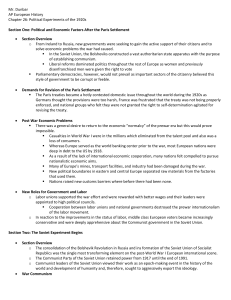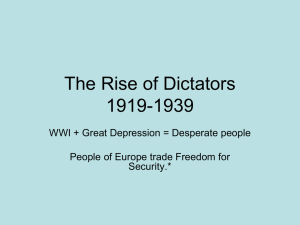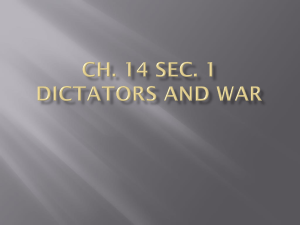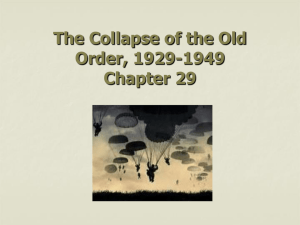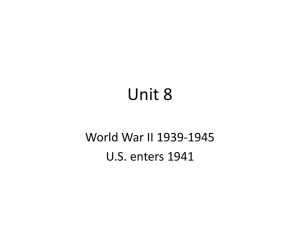Political Experiments in 1920s Europe: Lecture Notes
advertisement
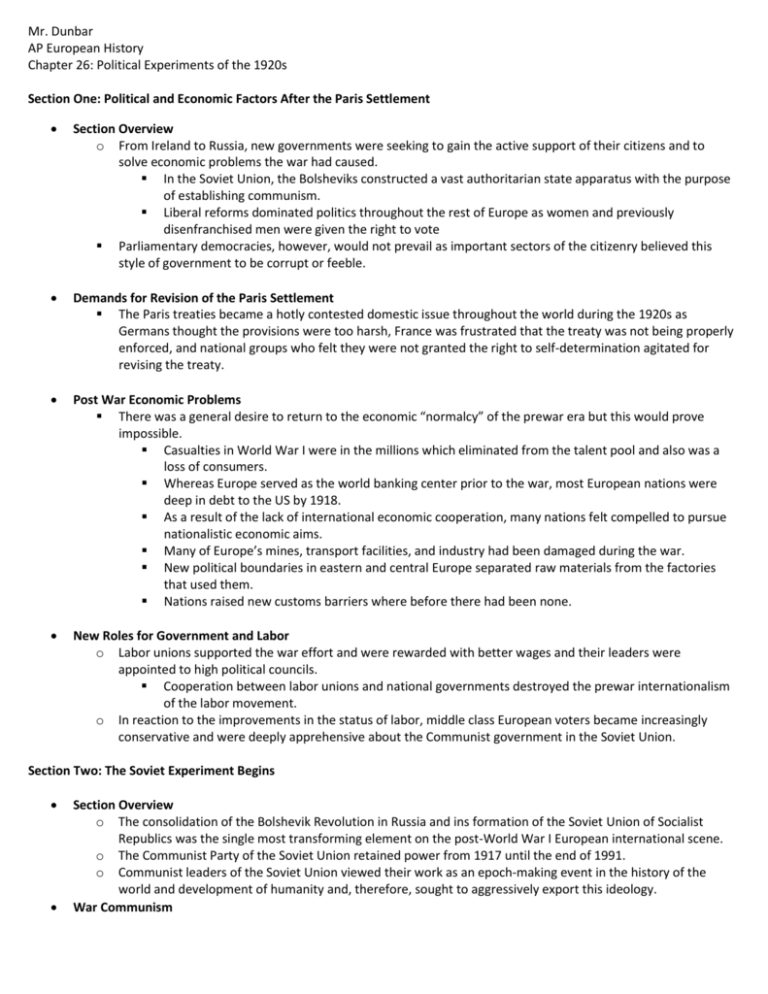
Mr. Dunbar AP European History Chapter 26: Political Experiments of the 1920s Section One: Political and Economic Factors After the Paris Settlement Section Overview o From Ireland to Russia, new governments were seeking to gain the active support of their citizens and to solve economic problems the war had caused. In the Soviet Union, the Bolsheviks constructed a vast authoritarian state apparatus with the purpose of establishing communism. Liberal reforms dominated politics throughout the rest of Europe as women and previously disenfranchised men were given the right to vote Parliamentary democracies, however, would not prevail as important sectors of the citizenry believed this style of government to be corrupt or feeble. Demands for Revision of the Paris Settlement The Paris treaties became a hotly contested domestic issue throughout the world during the 1920s as Germans thought the provisions were too harsh, France was frustrated that the treaty was not being properly enforced, and national groups who felt they were not granted the right to self-determination agitated for revising the treaty. Post War Economic Problems There was a general desire to return to the economic “normalcy” of the prewar era but this would prove impossible. Casualties in World War I were in the millions which eliminated from the talent pool and also was a loss of consumers. Whereas Europe served as the world banking center prior to the war, most European nations were deep in debt to the US by 1918. As a result of the lack of international economic cooperation, many nations felt compelled to pursue nationalistic economic aims. Many of Europe’s mines, transport facilities, and industry had been damaged during the war. New political boundaries in eastern and central Europe separated raw materials from the factories that used them. Nations raised new customs barriers where before there had been none. New Roles for Government and Labor o Labor unions supported the war effort and were rewarded with better wages and their leaders were appointed to high political councils. Cooperation between labor unions and national governments destroyed the prewar internationalism of the labor movement. o In reaction to the improvements in the status of labor, middle class European voters became increasingly conservative and were deeply apprehensive about the Communist government in the Soviet Union. Section Two: The Soviet Experiment Begins Section Overview o The consolidation of the Bolshevik Revolution in Russia and ins formation of the Soviet Union of Socialist Republics was the single most transforming element on the post-World War I European international scene. o The Communist Party of the Soviet Union retained power from 1917 until the end of 1991. o Communist leaders of the Soviet Union viewed their work as an epoch-making event in the history of the world and development of humanity and, therefore, sought to aggressively export this ideology. War Communism o o o o o Within the Soviet Union, the Red Army, under the organizational direction of Leon Trotsky (1879-1940), eventually suppressed internal and foreign military opposition to the new government. Military threats to the new government allowed the Bolsheviks to pursue authoritarian policies more rapidly than they otherwise would have been able to do. Cheka, the Bolshevik secret police, helped ensure the success of the revolution. All decisions came from the top in a non-democratic manner. Throughout the civil war, the government, headed by Lenin, repressed all actual or potential sources of opposition. The New Economic Policy o Internal enemies force Lenin to take swift action on adopting a new economic policy Rural peasantry was enraged for having their grain taken to feed the urban population Baltic fleet mutinied in March 1921, but it was crushed o The New Economic Policy Other than banking, the government vowed to be tolerant of private enterprise in heavy industry, transportation, and international commerce. Likewise, peasants could farm for profit. o Major problems with the NEP Peasants remained incapable of purchasing consumer goods on the profits they made from selling grain. o Triumphs of the NEP By 1927, Russia reached the industrial production it achieved in 1913. Russia was seemingly transformed into a land of small farmers and owners of private shops and businesses. Stalin Versus Trotsky o Section Overview The NEP caused disputes within the Politburo, the governing Committee of the Communist Party, as some believed the return to quasi-capitalist principles betrayed Marxist ideology; having suffered a stroke in 1922, Lenin died in 1924. Two factions emerged: one headed by Leon Trotsky and the other by Joseph Stalin. o Trotsky’s Position Believed that Russia must rapidly industrialize and work to spread revolution as Russia needed the wealth and resources of other nations to help build its own economy. Agriculture should be collectivized and the peasants should be made pay for industrialization o Stalin’s Rise Stalin had not spent time in exile in Western Europe like other communist leaders in Russia and was, therefore, neither as intellectual nor internationalist in his outlook. Stalin worked as “commissar of nationalities” under Lenin and was known for his cruel treatment of recalcitrant nationalist groups. Gained power due to his command of bureaucratic and administrative methods which he manipulated to gain the support of the lower levels of the apparatus when he clashed with party leaders. Nikolai Bukharin, the editor of Pravda (Truth) which was the communist party’s newspaper, led the opposition against Trotsky’s call for rapid industrialization. Stalin quickly supported Bukharin’s opposition to Trotsky and added that the success of Russia’s communist revolution was not dependent on revolutions elsewhere; therefore, Stalin nationalized the scope of Marx’s international prediction. Stalin used his control over the Central Committee of the Communist Party to edge out Trotsky and his supporters; and by 1927 Trotsky had been removed from all his offices, kicked out of the party, and exiled to Siberia. Trotsky was forced from Russia in 1929 and moved to Mexico where he was murdered in 1940 by one of Stalin’s agents. The Third International o In 1919, the Soviet communists founded the Third International of the European socialist movement, better known as the Comintern. o The goal of the Comintern was to work to make the Bolshevik model of socialism the rule for all socialist parties outside the Soviet Union. o Twenty-one Conditions of the Comintern Required the acknowledgement of Moscow’s leadership and rejection of reformist socialism o As a result, separate social democratic and communist parties emerged in many countries. Many communist pledged loyalty to Moscow Social democrats attempted to pursue both social reform and liberal parliamentary politics. o The fear of a Soviet take-over of the government can’t be underestimated in the cause for the rise of fascism in Europe during the 1920s and 1930s. Women and the Family in the Early Soviet Union o Alexandra Kollontai (1872-1952) was a social utopian writer who wrote Communism and the Family She envisioned a new type of family—that advocated sexual freedom and camaraderie—that would liberate both men and women. Although her ideas did not really reflect practice in the Soviet Union, Kollontai’s book constituted a social vision of the bold new life being forged in the Soviet Union. o Family Legislation from Reform to Repression Bolshevik laws, issued in 1917, made divorce far easier for women, marriage was no longer a religious ceremony, legitimate and illegitimate children were given the same rights, women were given more protection in the workplace, and abortion was legalized in 1920. Dislocation from civil war, the confiscation of property, and the shifting economic policies of the 1920s took its toll on the Soviet family as domestic violence appears to have been common, birthrate fell, and housing issues caused divorced couples to continue to live in the same household. From the 1920s onward, women could earn leadership positions in the economy and the party, though they seldom achieved the top ranks. Section Three: The Fascist Experiment in Italy Section Overview o Italy witnessed the first authoritarian political experiment in Western Europe that arose in part from the fears of the spread of Bolshevism. o From the fascist movement in Italy of Benito Mussolini, the term fascism has frequently been used to describe a number of right-wing dictatorships that arose across Europe between the wars. o The exact definition of the term fascism is a matter of debate but the following characteristics are often associated with this ideology: anti-democratic, anti-communist, anti-parliamentary, and frequently antiSemitic. o Fascist deplored the liberalism of the 19th century as they believed parliamentary politics restricted greatness as petty disputes thwarted progress; therefore, they sought to overcome the class conflict of Marxism and the party conflict of liberalism by uniting the various groups and classes within the nation to achieve national purposes. o Fascist political movements drew upon the scorn for reason in political life that many late nineteenth-century thinkers had voiced, like Hegel’s notion that great leaders were needed to effect real changes in history. o Memories of great nineteenth century leaders like Garibaldi and Bismarck paved the way for a cult of heroes to emerge in Europe during the twentieth century, starting with Mussolini in the 1920s and then Hitler in the 1930s. The Rise of Mussolini o Section Overview The Italian Fasci di Combattimento, or “Bands of Combat,” was founded in 1919 in Milan and its membership came largely from Italian war veterans who felt the Paris conference had cheated Italy; they were particularly angry that Italy was not given Fiume (now Rijeka in Slovenia) on the northeast coast of the Adriatic Sea. o o o Mussolini—son of a blacksmith—worked as a teacher and day laborer before becoming active first in socialist politics and then fascism. Mussolini established his own newspaper, Il Popolo d’Italia (The People of Italy), in which he espoused a plan to transform Italy from a weak liberal state to a strong unified nation. Postwar Italian Political Turmoil During World War I, the Italian parliament had virtually ceased to function and many Italians grew dissatisfied with the parliamentary system and nearly all Italians felt that Italy had not been treated as a great power at the Paris Conference. Gabriele D’Aunnunzio was an extreme nationalist writer who seized Fiume with a force of patriotic Italians and this showed the Italian government how a nongovernmental military force could be put to political use. Industrial strikes were common, peasants seized uncultivated land from large estates. Socialist Party and Catholic Popular Party dominated the lower house of the Italian Parliament, the Chamber of Deputies, but neither party would cooperate with the other which resulted in parliamentary deadlock and many in Italy feared this inaction would lead to a communist revolution. Early Fascist Organization Mussolini discovered that many upper and middle class Italians sought order, rather than some vague form of social justice and he began organizing attacks on Socialist Party meetings, and he ordered the beatings, and intimidation, of socialist leaders By 1922, fascist were intimidating local officials through arson, beatings, and murder in cities such as Ferrara, Ravenna, and Milan; they essentially controlled the local government in much of northern Italy. March on Rome Following the election of 1921 when Mussolini and 34 of his followers were elected to the Chamber of Deputies, the growing fascist party organized a haphazard march on Rome, which became known as the Black Shirt March. King Victor Emmanuel III—for both personal and political reasons—refused to sign a decree that would have authorized the army to stop the marchers and then proceeded to send Mussolini a telegraph which asked him to become prime minister. The Fascists in Power o Section Overview Mussolini had no majority or nearly a majority in the Chamber of Deputies and, therefore, worked to sure up his support and consolidate his power. On November 23, 1922, the king and Parliament granted Mussolini dictatorial authority for one year to bring order to local and regional government. o Repression of Opposition Change in voting laws in 1924 Previously, parties had been represented in the Chamber of Deputies in proportion to the popular vote cast for them. According to the new election law, the party that gained the largest popular vote (if they won at least 25 percent) received two-thirds of the seats in the chamber o Predictably, in the election of 1924, the fascist won complete control of the Chamber of Deputies and laws passed in 1925 and 1926 permitted Mussolini to rule by decree. Fascists were put in charge of the police force and the terrorist squads became a government militia. In 1924, the fascist police murdered Giacomo Matteotti, a leading non-communist, socialist leader and member of Parliament, who frequently criticized Mussolini’s fascist policies. A cult of personality developed around Mussolini as his courage was admired by many who believed he saved them from Bolshevism. o Accord with the Vatican Lateran Accord of February 1929 The Roman Catholic Church and the Italian state made peace with each other which ended a dispute that erupted when the Italian national government seized papal lands in the unification effort. This agreement of 1929 recognized the pope as the temporal ruler of the independent state of Vatican City. The Italian government agreed to pay an indemnity to the papacy for the territory it seized, and the state also recognized Catholicism as the religion of the nation, exempted church property from taxes, and allowed church law to govern marriage. This agreement brought further respectability to Mussolini’s authoritarian regime. Motherhood for the Nation in Fascist Italy o Fascist policy encouraged women to have more children and to stay in the home and rear them for the good of the nation. Despite the encouragement to remain in the home, Italian women made up 25 percent of the Italian workforce. Nonetheless, by World War II, this figure dropped to 10 percent. o Legislation outlawing contraception and abortion and discouraging the publication of information about sexuality and reproduction made it difficult for women to limit the size of their families. o Italian mothers were expected to see that their children attended fascist school programs. Section Four: Joyless Victors France: The Search for Security o Section Overview At the close of World War I, as after Waterloo, the revolution of 1848, and the defeat of 1871, the French voters elected a conservative Chamber of Deputies. Conservatives believed that France and the Allies were too lenient, mainly due to the fact that French representative, Clemenceau, failed to establish a separate Rhineland state under French influence. Between the end of the war in 1918 and January 1933, twenty-seven different cabinets took office in France. o New Alliances “The Little Entente” France sought to establish new alliances in the east to replace Russia and formed a network of alliances with Czechoslovakia, Romania, and Yugoslavia. France also made an alliance with Poland. Germany and the Soviet Union were isolated from European affairs. While European states were holding an economic conference in Genoa, the Russians and Germans met at nearby Rapallo and signed a treaty of their own. The Rapallo treaty convinced France that Germany was not intending to abide by the provisions of the Versailles treaty and this led France toward strong action. o Quest for Reparations In 1923, the Allies, led by the French prime minister Raymond Poincare (1860-1934), declared Germany to be in technical default of their payments and it was decided that a coalition of French and Belgium troops would be sent to occupy the Ruhr. German government encouraged passive resistance and many German workers went on strike. o The French government sent French workers to fill the positions of the striking German workers. o The French were successful in this endeavor but the alienated the British who felt sympathetic for the Germans. Poincare’s conservative ministry gave way to a coalition of leftist parties, the so called Cartel des Gauches. Led by Edouard Herriot (1872-1957), this new cabinet recognized the Soviet Union and adopted a more conciliatory policy toward Germany. o Aristide Briand (1862-1932) was the foreign minister under Herriot who championed the League of Nations and tried to persuade France that its military power did not give it unlimited influence in foreign affairs of Europe. As a result of inflation, the value of the franc fell sharply on the world market in 1926 and Poincare reemerged as the head of the national government of several parties. The value of the franc recovered under conservative leadership and they would remain in power in France for the remainder of the 1920s. Great Britain: Economic Confusion o Section Overview World War I profoundly transformed the political landscape of Great Britain as Parliament extended the electorate to include all men aged twenty-one and women aged thirty. British politics during the war and thereafter A coalition cabinet of Liberal, Conservative, and Labour ministers directed the war effort o The war further divided the Liberal party Until 1916, Liberal prime minister Herbert Asquith (1852-1928) had presided over the cabinet but disagreements led fellow liberal, David Lloyd Geroge (1863-1945) to replace him. The party split sharply between the followers of the two men. The split in the liberal party led to a majority of conservatives elected to the House of Commons Britain’s economy plummeted with unemployment rates at eleven percent and the government expanded its insurance programs to cover unemployed workers, widows, and orphans. Morale was low in Great Britain throughout the 1920s. o The First Labour Government Conservatives replaced David Lloyd George with Andrew Bonar Law (1858-1923), one of their own, as prime minister. A liberal would never again be prime minister of Great Britain. Law’s successor, Stanley Baldwin, attempted to abandon free trade and institute protective tariffs, but this led to the loss of seats for the Conservative party lost its majority. King George V asked Ramsay MacDonald (1866-1937) to form the first Labour ministry in British history. The Labour party was socialistic in its platform but democratic and distinctly nonrevolutionary MacDonald’s program consisted of plans for extensive social reform rather than for the nationalization or public seizure of industry. Due to the success of MacDonald’s Labour ministry, most liberals had made the conversion to the Labour party and the presence of liberalism remained a weak force in British politics. o The General Strike of 1926 The Labour government fell in 1926 after charges of inadequate prosecution of a communist writer and the Conservative Party took over. Conservative government returned to the gold standard but failed to set the value of the pound properly which led to increase prices of British goods on the world market; consequently, British industrialists lowered employee wages in an attempt to reduce the cost of the products. Strike in the coal industry is supported by workers in other industries Despite the harsh economic climate of this period, the average standard of living improved for most people in Britain during this period. o Empire Under the leadership of Ghandi, India gained some freedom from British dominance during the 1920s. o Ireland In 1914, the Irish Home Rule Act was passed but its implementation was postponed until after the war. As the war continued to drag on, Irish nationalists revolted in Dublin but the rebellion was quickly crushed by the British who executed the nationalist leaders. Leadership of the nationalist cause in Ireland shifted from the Irish Party in Parliament to the extremist Sinn Fein, or “Ourselves Alone.” Sinn Fein Party won all but four Irish parliamentary seats during the 1918 election but refused to go to Westminster for Parliament and instead formed an Irish Parliament. Sinn Fein declared Ireland’s independence on January 21, 1919. The military wing of Sinn Fein became the Irish Republican army. The first president was Eamon De Valera (1882-1975) A guerilla war broke out between the IRA and the British army. In late 1921, the Irish and British governments worked out a treaty in which the Irish Free State took its place beside the earlier dominions in the British Commonwealth like Canada, Australia, New Zealand, and South Africa. Northern Ireland was permitted to remain part of what was now called the United Kingdom of Great Britain and Ireland, with provisions for home rule. Civil war broke out in Ireland between moderates, who supported the treaty, and diehards, led by De Valera, who wanted complete independence for Britain. In 1933, the Irish Parliament abolished the oath of allegiance to the British monarchy. Ireland remained neutral during World War II and declared itself wholly independent in 1949. Section Five: Trials of the Successor States in Eastern Europe Section Overview o Nineteenth-century liberals believed that only good could come from the destruction of Austria-Hungary as new states—which embodied the principles of self-determination—could provide Europe with a buffer against the westward spread of Bolshevism. o The challenge for Germany, Poland, Austria, Czechoslovakia, and other successor states, was to make new parliamentary governments function in a stable manner. Keep in mind that although Germany and Austria both maintained parliaments prior to World War I, the parliaments in these nations possessed little power. o Another question was how long conservative political groups and institutions, such as armies, would tolerate or cooperate with liberal experiments. Economic and Ethnic Pressures o World War I, and the new national boundaries produced by the Paris conference, disrupted the previous economic relationships in Europe that allowed the Continent to achieve economic prosperity in the prewar years. o Most of the successor states were completely dependent on outside loans to stimulate their economies and, furthermore, nationalistic antagonisms often prevented these states from trading with each other. o Each successor state included minority groups that agitated for independence which led to the emergence of authoritarian governments in central and eastern Europe. Poland: Democracy to Military Rule o An independent Poland had been one of Wilson’s Fourteen Points, and when the country was restored in 1919, nationalism proved an insufficient bond to overcome political disagreements stemming from class differences, diverse economic interests, and regionalism. Due to the fact that Russia, Austria, and Germany had ruled over the different parts of Poland for the past century, the separate regions had few common economic and political experiences which caused problems for new nation in 1919. A host of small political parties prevented the Polish Parliament from taking any significant action. o In 1926, Marshal Josef Pilsudski (1867-1935) carried out a military coup and ruled Poland until his death in 1935 when power was passed to a group of his military followers. Czechoslovakia: A Viable Democratic Experiment o Czechoslovakia was the one successor state that escaped authoritarian government in the interwar period. o It possessed a strong industrial base, a substantial middle class, and a tradition of liberal values. o Thomas Masaryk (1850-1937) provided his nation with fair and intelligent leadership. o Problems in Czechoslovakia Slovaks, Poles, Magyars, Ukrainians, and Germans in Czechoslovakia resented Czech prosperity and leadership. Germans in the region of the Sudetenland, ceded to Czechoslovakia at the Paris conference, looked to Hitler for help in achieving reunification with Germany. o Munich Conference of 1938 The great powers met and decided to divide liberal Czechoslovakia to appease Hitler; they then sat idly by as Hitler occupied most of the country by 1939. Hungary: Turn to Authoritarianism o Hungary was one of the defeated powers in World War I and achieved long-desired separation from Austria, but at a high political and economic price. In 1919, Bela Kun, a communist, established a short-lived Hungarian Soviet Republic, which received socialist support. The Allies sent a Romanian force to remove the communist danger. Admiral Miklos Horthy (1867-1957), supported by the landowners, took control of the country as regent for the Habsburg monarchy who could not return to its throne. Thousands were executed and imprisoned following the removal of Kun from office. Hungarians were angry about their loss of territory at the Paris conference. The primarily agrarian Hungarian economy suffered from great stagnation during the 1920s. Hungarian government in the 1920s and 1930s Count Stephen Bethlen presided over the parliamentary, yet characteristically aristocratic, government of Hungary. He was succeeded by General Juliu Gombos (1886-1936), who pursued anti-Semitic policies and rigged elections. Austria: Political Turmoil and Nazi Occupation o Austria’s landscape after World War I One quarter of Austria’s eight million citizens lived in Vienna which created an impossible economic situation. Politically, the leftist Social Democrats and the conservative Christian Socialists contended for power. Both groups possessed small armies to terrorize their opponents and to impress their followers. In 1933, Christian Socialist Engelbert Dollfuss (1892-1934) became chancellor. o He fought against German Nazi influence which had surfaced in Austria. o He outlawed all political parties except his own followers that were known as the Fatherland Front. o He authorized force against the Social Democrats, and was later shot that year during an unsuccessful coup attempt by the Nazi party. o His successor, Kurt von Schusnigg (1897-1977), presided over Austria until Hitler annexed it in 1938. Southeastern Europe: Royal Dictatorships o Yugoslavia was founded by the Corfu Agreement of 1917 which created the kingdom of the Serbs, Croats, and Slovenes which lasted until 1929. The Serbs dominated the government and were opposed by the Croats. The two groups clashed but the Serbs held a strong advantage since they had an independent state prior to World War I which had its own army. Cultural differences The Croats generally were Roman Catholic, better educated, and accustomed to reasonably incorrupt government. The Serbs were Orthodox, somewhat less educated, and considered corrupt administrators by the Croats. Other groups and their role in affairs of state Slovenes, Muslims, and other small nationalist groups often played the Serbs and Croats against each other. Violent clashes among ethnic groups led to the seizure of power by King Alexander I (r.1921-1934) who was a Serb. Alexander was assassinated in 1934 but authoritarian rule continued under a regent serving for his son o Royal dictatorships were established elsewhere in the Balkans who believed that they were preventing radical groups from taking control of government and quieting uprisings by national groups. Romania by King Carol II Bulgaria by King Boris III King George II in Greece. Section Six: The Weimar Republic in Germany Section Overview o The Weimar Republic was the triumph of Social Democrats in Germany amidst the collapse of the monarchy and revolution against the Hohenzollerns. o Social Democrats, representing the Weimar Republic, accepted the terms of the Versailles treaty that everyone found appalling. They signed under threat of Allied invasion and the continuance of the naval blockade. o Although all Germans disagreed with the Versailles treaty, some thought it wise to oppose the treaty only when it tacitly made sense, while others desired complete opposition to it. Constitutional Flaws o Weimar constitution was an enlightened document as it guaranteed civil liberties and provided for direct election, by universal suffrage, of the parliament, the Reichstag, and the president. o Some major flaws The Weimar Constitution provided for proportional representation in all elections which created a Reichstag full of small party members. President was responsible, alone, for appointing and dismissing the chancellor Article 48 of the Weimar Constitution allowed the president to rule by decree in an emergency. Lack of Broad Popular Supprt o The Social Democrat revolution is Germany was not coupled with a cultural revolution and, therefore, many schoolteachers, civil servants, and judges of the republic were the same people in these positions under the Kaiser, and many people were suspicious of the government Discontentment of the German officer corps who believed politicians at home betrayed them during the war by signing the armistice which led to the dreadful terms of the Versailles treaty. o Economic instability throughout the 1920s hurt the fledgling Weimar government and the Social Democrats responsible for its conception. o Kapp Putsh, or “armed insurrection” of 1920 This was an attempted coup of the government in Berlin in 1920—which failed--led by conservative civil servants and supported by the officer. o German government was presented with a bill for 132 billion gold marks which they accepted due to the threat of an Allied occupation. Numerous assassinations and attempts occurred against republican leaders Invasion of the Ruhr and Inflation o German currency problems Inflation, caused by borrowing to finance the war effort and continued postwar deficit spending, led to the fall in the value of the German currency. By early 1921, the German mark traded at a ratio of 64 to 1 against the America dollar whereas it had been 4.2 to 1 in 1914. In November 1923, an American dollar was worth more than 800 million German marks. Middle class savings, pensions, and insurance policies were wiped out. German bankers believed the currency would not recover until the reparations issue had been solved. o French invasion of the Ruhr in January 1923, and the German passive resistance which led to rampant strikes, created a new drain on the German economy. Hitler’s Early Career o Background son of a minor Austrian customs official dream of becoming an artist were dashed when he failed to gain admittance to art school. For a while, he lived off money his mother sent him and then an Austrian “orphans allowance.” Worked as a day laborer, painted, and sold postcards o Political influences Hitler learned about Vienna Mayor Karl Lueger’ (1844-1910) Christian Social Party and its antiSemitic ideology. He absorbed the rabid anti-Semitism, German nationalism, that flourished in Vienna. Hitler moved to Munich in 1920 during a tumultuous year of postwar conflict and became associated with the National Socialist German Workers’ Party. o Origins of NAZI Ideology IN 1920, the National Socialists began parading under a red and white banner with a black swastika. Platform of the NAZI party was known as the Twenty-Five Points called for the unification of Germany and Austria advocated complete repudiation of the Versailles treaty demanded the exclusion of Jews from German citizenship wanted state administration of giant business cartels suggested the replacement of department stores by small retail shops Hitler redefined the term “socialism”—as it applied to his party’s name—by strongly connecting it to the idea of nationalism. For example, the “socialism” Hitler and the Nazis wanted was not state ownership of the means of production, but the subordination of all economic enterprise to the welfare of the nation. o Following the publication of the “Twenty-Five Points,” the Nazis organized the storm troopers, or SA (Sturmabteilung) under the leadership of Ernst Roehm (1887-1934). SA served as the chief instrument of terror and intimidation before the party controlled the government. In response to the formation of the SA, the Social Democratic Party and the Communist party organized paramilitary organizations of their own. o Hitler dominated the Nazi Party and modeled his approach after that of Mussolini in Italy. both men recruited from disillusioned veterans of the world war both adopted paramilitary styles of organization both disparaged liberal politics of incapable of achieving great national ends both exalted the idea of obedience to the national hero o Beer Hall Putsch of 1923 Hitler and a band of followers, accompanied by General Ludendorff, attempted an uprising from a beer hall in Munich. Sixteen Nazis were killed when the German authorities crushed it. Hitler and Ludendorff were charged with treason and put on trial Ludendorff was acquitted Hitler was convicted and sentenced to five years; he also used the trial as a platform to express his vision of Germany. o Hitler wrote Mein Kampf, or My Struggle, while in prison which expressed his political thoughts Advocated fierce racial anti-Semitism Opposition to Bolshevism Conviction that Germany must expand eastward into Poland and Ukraine to achieve greater “living space.” o Prison Apotheosis—two things Hitler realized while in prison First, he came to see himself as the leader who could transform Germany from a position of weakness to strength. Second, he determined that he and the party must pursue power through legal means The Stresemann Years o Gustav Stresemann was German chancellor responsible for reconstructing the German republic and giving it a sense of self-confidence. He abandoned the policy of passive resistance in the Ruhr. With help from the banker Hjalmar Schacht (1877-1970), he introduced a new German currency, the Rentenmark which was traded at a rate of one trillion to one of the old German marks. Dawes Plan of 1924 Plan outlined by the American banker Charles Dawes, it was a new system for Germany to pay off reparations which allowed the Germans to pay according to the fortunes of the German economy. The last French troops left the Ruhr in 1925. o In 1925 Field Marshal Paul von Hindenburg, a military hero and conservative monarchist, became president when the Social Democrat president, Friedrich Ebert (1871-1925), died. Hindenburg’s conservative government was responsible for economic development in Germany in the late 1920s. o Stresemann’s later career was marked by his acceptance of the treat provisions as it pertained to the West, but he had aspirations to recover German-speaking territories lost to Poland and Czechoslovakia, and to possibly unite with Austria. Locarno o Locarno Agreements of October 1925 France and Germany both accepted the westward frontier established at the Paris conference. Britain and Italy agreed to intervene against whichever side violated the frontier or if Germany sent troops into the demilitarized Rhineland. German made no agreements about its eastern frontier. France supported Germany’s admittance into the League of Nations and agreed to withdraw French troops from the Rhineland by 1935, five years earlier than that which was specified by the Versailles treaty. o Locarno Agreements brought a sense of hope to Europe and the political figures responsible for its completion each received a Nobel Peace Prize, but trouble lurked beneath the surface. France proved it was unable to coerce Germany without help from other powers. Britain proved its unwillingness to enforce the Versailles treaty, especially as it pertained to the East. Germany and the Soviet Union continued to form closer military bonds. o The Great Depression devastated Europe early in 1930 and destroyed the temporary prosperity and optimism.
